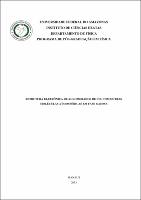| ???jsp.display-item.social.title??? |


|
Please use this identifier to cite or link to this item:
https://tede.ufam.edu.br/handle/tede/4371| ???metadata.dc.type???: | Dissertação |
| Title: | Estrutura eletrônica de aglomerados de CO2 com outras moléculas atmosféricas em fase gasosa |
| ???metadata.dc.creator???: | Souza, Marcílio Bárcry  |
| ???metadata.dc.contributor.advisor1???: | Chaudhuri, Puspitapallab |
| ???metadata.dc.description.resumo???: | Dióxido de carbono (CO2) é uma das moléculas mais conhecidas e utilizadas tanto no mundo científico quanto na sociedade em geral. Ela está presente em todo lugar desde o espaço interestelar até nas águas dos mares. Ela está presente nas plantas, no sangue humano e também nos refrigerantes industrializados. Como um gás de estufa, ela absorve a radiação infravermelha emitida pela terra que causa o aumento da temperatura terrestre. Por isso, o assunto de interações intermoleculares entre as moléculas de CO2 com CO2 e também outras moléculas é um dos mais importantes e atual na pesquisa de física molecular e química quântica. Vários trabalhos experimentais, principalmente com espectroscopia dos dímeros e trímeros de CO2 já foram feitos nas últimas décadas. O número de trabalhos teóricos sobre aglomerados de CO2 é bastante inferior em comparação com experimental. A respeito disso é de grande importância ter informações sobre interações intermoleculares e propriedades espectroscópicas de sistemas moléculares contendo CO2. Com esta motivação, estudamos interações intermoleculares com o próprio CO2, com a água (H2O), ácido carbônico (H2CO3) e metanol (CH3OH) formando dímeros, trímeros e tetrâmeros estabilizados pelas interações intermoleculares tipo Van der Waals usando o método da Teoria de Funcional da Densidade (DFT). Esses aglomerados podem ser representados por ( ) , onde e H2O, CH3OH, H2CO3 e CO2. Diferentes bases gaussianas e funcionais da DFT formam os seguintes modelos utilizados para otimizar as geometrias de aglomerados homogênios e heterogênios de CO2 e cálculo de superfície de potencial mínima: B3LYP/6-311++G(d,p), B3LYP/aug-cc-pVDZ, BHandHLYP/6-311++G(d,p), BHandHLYP/aug-cc-pVDZ. A presença de interações intermoleculares de Van der Waals e a formação de ligação de hidrôgenio mudam as propriedades estruturais, energéticas, elétricas e espectroscópicas. Neste presente trabalho, apresentamos uma análise sistemática sobre as variações de propriedades estruturais e energéticas (energia da ligação, ponte de hidrogênio) e elétricas (momento dipolo, polarizabilidade média) nos vários aglomerados de CO2 em fase gasosa. |
| Abstract: | Carbon dioxide (CO2) is one of the most well-known and commonly used molecules in the scientific world as well as in human society, in general. It is present everywhere from the interstellar space to the ocean waters. It is present in plants, in human blood and also in industrial refrigerants. As a greenhouse gas, it absorbs the infrared radiation emitted by the earth which causes the increase in the atmospheric temperature. So, the study of intermolecular interactions between the molecules of CO2 with itself and other molecules is one of the most important and current research topics in molecular physics and quantum chemistry. Several experimental studies, mainly with spectroscopy of dimers and trimers of CO2 have been performed in recent decades. However, the number of theoretical works on clusters of CO2 is much lower compared to experiments. In this regard it is of great importance to have information on intermolecular interactions and spectroscopic properties of molecular systems containing CO2. With this motivation, we study intermolecular interactions with CO2 with itself as well as with water (H2O) , carbonic acid (H2CO3) and methanol (CH3OH) forming dimers, trimers and tetramers through van der Waals type intermolecular interactions using the method of Density Functional Theory (DFT) . These clusters can be represented by (CO2)n + X , where n = 1, 2, 3 and X = H2O, CH3OH, CO2 and H2CO3. Four different quantum chemical models formed by various combinations of different Gaussian basis sets and DFT functionals have been used to optimize the molecular geometries and to calculate the minimum of the potential energy surface of each homogeneous and heterogeneous CO2 cluster. The models are: B3LYP/6-311++G(d,p), B3LYP/aug-cc-pVDZ, BHandHLYP/6-311++G (d,p), BHandHLYP/aug-cc-pVDZ. The presence of intermolecular van der Waals interactions and the formation of hydrogen bonds introduce changes in structural energetics as well as in electrical and spectroscopic properties. In this work, we present a systematic analysis of the changes in the structural and energetic properties (formation of hydrogen bond, binding energies), electric properties (dipole moment, average polarizability) and spectroscopy of several clusters of CO2 in the gas phase. |
| Keywords: | Dióxido de Carbono Aquecimento global Efeito Estufa Hartree-Fock Teoria do Funcional da Densidade |
| ???metadata.dc.subject.cnpq???: | CIÊNCIAS EXATAS E DA TERRA: FÍSICA |
| Language: | por |
| ???metadata.dc.publisher.country???: | Brasil |
| Publisher: | Universidade Federal do Amazonas |
| ???metadata.dc.publisher.initials???: | UFAM |
| ???metadata.dc.publisher.department???: | Instituto de Ciências Exatas |
| ???metadata.dc.publisher.program???: | Programa de Pós-graduação em Física |
| Citation: | SOUZA, Marcílio Bárcry. Estrutura eletrônica de aglomerados de CO2 com outras moléculas atmosféricas em fase gasosa. 2013. 120 f. Dissertação (Mestrado em Física) - Universidade Federal do Amazonas, Manaus, 2013. |
| ???metadata.dc.rights???: | Acesso Aberto |
| URI: | http://tede.ufam.edu.br/handle/tede/4371 |
| Issue Date: | 16-Dec-2013 |
| Appears in Collections: | Mestrado em Física |
Files in This Item:
| File | Description | Size | Format | |
|---|---|---|---|---|
| Dissertação - Marcílio Bárcry Souza.pdf | Dissertação - Marcílio Bárcry Souza | 3.76 MB | Adobe PDF |  Download/Open Preview |
Items in DSpace are protected by copyright, with all rights reserved, unless otherwise indicated.




